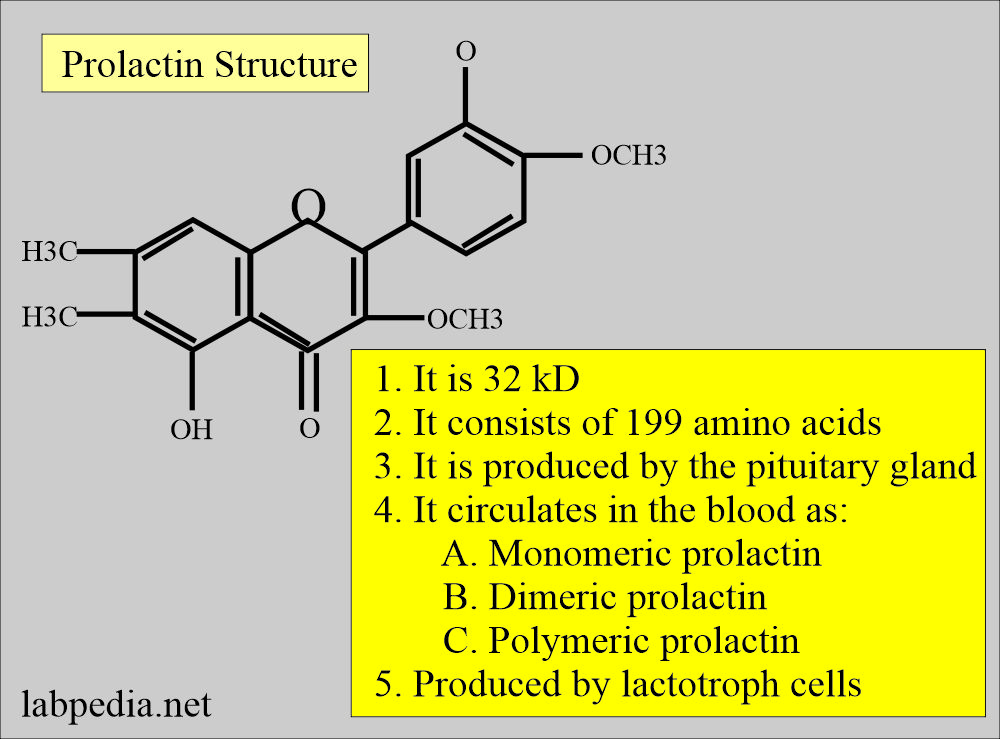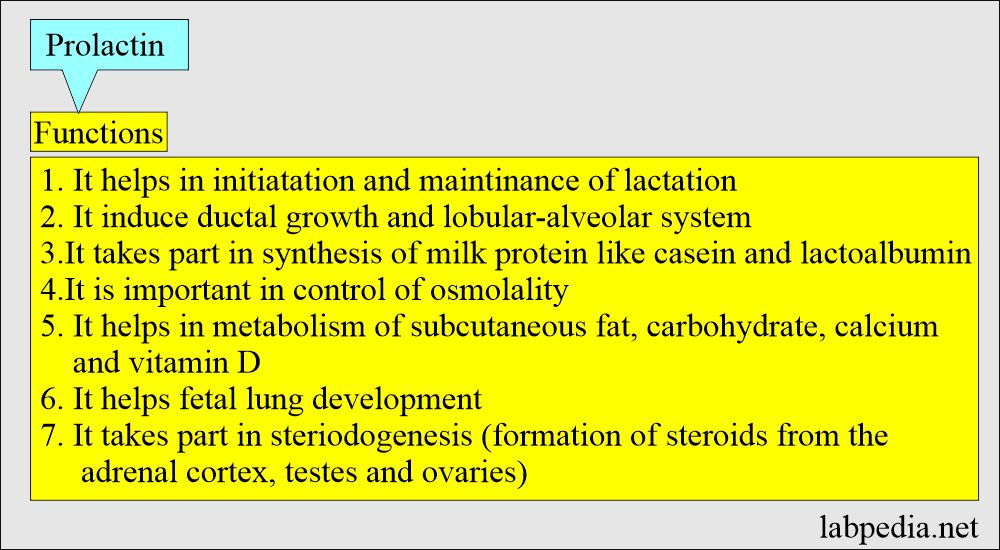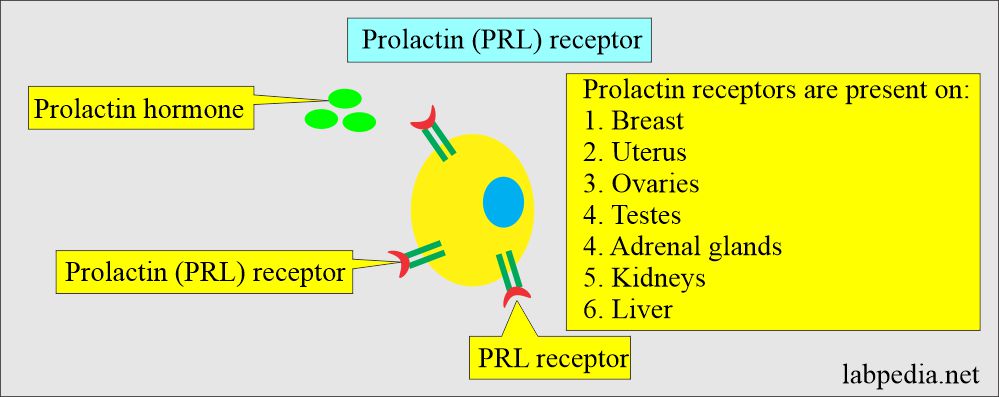Prolactin (PRL)
Prolactin (PRL)
What sample is needed for the Prolactin (PRL) level?
- This is done on the patient’s serum.
- The patient needs to be fasting for 12 hours.
- Take the blood sample after 3 to 4 hours of waking from sleep because:
- The level rises during deep sleep.
- There is a peak in the early morning hours.
- The sample may be stored at 4 °C for 24 hours.
- For a long time, the sample can be kept frozen.
- In case of borderline elevation of PRL:
- Repeat the estimation at least two times at some intervals.
- Take the sample in the morning.
- Avoid excitement in the patient.
- Avoid breast stimulation and no trauma.
- No medication which can stimulate the PRL release like:
- Estrogen.
- Dopamine antagonists (metoclopramide, domperidone, haloperidol).
- Advise TSH in such cases where primary hypothyroidism can elevate PRL.
What are the precautions for Prolactin (PRL)?
- Take a sample in the morning between 8 and 10 AM after at least 3 to 4 hours of wakefulness.
- It increases during sleep, and the peak is in the early morning.
- When collecting the sample, avoid emotional stress, exercise, and protein ingestion; all of these increase the prolactin level.
- In the case of the borderline raised level, advise estimation two more times and avoid breast stimulation, no trauma, and no interfering medication.
What are the indications for Prolactin (PRL)?
- Diagnose prolactin-producing tumors, like pituitary adenoma.
- Use to monitor prolactin-producing tumors.
- Used for secondary amenorrhoea or galactorrhea, infertility, and hyperprolactinemia.
- Useful for hypothalamic disease.
- Monitor the effectiveness of surgery, chemotherapy, and radiation in prolactin-producing tumors.
What is the pathophysiology of Prolactin (PRL)?
- The primary function of Prolactin is to initiate and maintain lactation. It stimulates lactation (Galactorrhea) in females.
- This is a lactogenic hormone synthesized by the specialized cells in the adenohypophysis.
- Prolactin induces ductal growth and develops the lobular system and synthesis of milk production.
- Prolactin is an anterior pituitary hormone used to initiate and maintain lactation.
- Prolactin, also called:
- Lactogen.
- Lactoropin.
- Luteotropin.
- Galactopoietic hormone.
- Mammotropin.
- Prolactin, also called:
- Prolactin release is stimulated by suckling and suppressed by stress.
- Until puberty, both males and females have the same level.
- Estrogen level gives rise to an increase in the prolactin level in females.
- TRH stimulates the release of prolactin from the pituitary gland.
What is the structure of Prolactin (PRL)?
- It is 32 kD and is synthesized as preprolactin.
- It consists of 199 amino acids and has three intramolecular disulfide bridges.
- It is produced by the pituitary gland’s lactotroph cells (acidophilic acids).
- It circulates in the blood as:
- Monomeric prolactin (PRL) = 23 kDa. This is also known as little prolactin.
- This is the most bioactive form than the other forms.
- It has the greatest response to TRH and hypothalamic-releasing factors that stimulate the pituitary glands.
- Dimeric prolactin (PRL) = 48 to 56 kDa. This is also known as big prolactin (PRL).
- Polymeric form prolactin (PRL) = >100 kDa. It is also known as big-big prolactin (PRL).
- Monomeric prolactin (PRL) = 23 kDa. This is also known as little prolactin.
- There is an increase in lactotroph cells during pregnancy.
What is the control of prolactin (PRL) secretion?
- Prolactin secretion is controlled by the following:
- Prolactin-inhibiting hormone, which is dopamine.
- Prolactin-releasing factor (PRF) is a thyrotropin-releasing hormone (TRH).
- Dopamine controls prolactin secretion. When more dopamine, then less prolactin.
- ACTH is increased with stress, leading to elevation of the PRL level.
- Last is the PRL feedback loop between the pituitary and hypothalamus.
- During sleep, prolactin levels increase 2 to 3 times.
What are the functions of Prolactin (PRL)?
- Prolactin has various functions in the body.
Where are the Prolactin receptors?
- Like other hormones, prolactin (PRL) has a receptor on the cell membrane of target organs, such as the breast, uterus, adrenal gland, testes, ovary, kidney, and liver.
What are the causes of increased prolactin levels?
- Breast stimulation.
- Pregnancy.
- Nursing.
- Stress.
- Exercise.
- Pituitary tumors form acidophilic cells that produce prolactin.
What are the causes of the moderate increase in Prolactin (PRL)?
- Secondary amenorrhea.
- Galactorrhea.
- Primary hypothyroidism.
- Polycystic ovary syndrome.
- Anorexia.
What is the normal level of Prolactin (PRL)?
Source 1
| Age | ng/mL | |
| Coed blood | 45 to 539 | |
| Newborn 1 to 7 days | 30 to 495 | |
| Children Tanner stage | Male | Female |
| 1 | <10 | 3.6 to 12 |
| 2 to 3 | <6.1 | 2.6 to 18 |
| 4 to 5 | 2.8 to 11.0 | 3.2 to 20 |
| Adult | ||
| 3.0 to 14.7 | 3.8 to 23.2 | |
|
Pregnancy 3rd trimester= 95 to 473 |
||
- To convert into SI unit x 1.0 = µg/L
- The Tanner stage is the physical scale of the development of primary and secondary sex characteristics.
Source 2
- Adult male = 0 to 20 ng/mL
- Adult female = 0 to 25 ng/mL
- Pregnant female = 20 to 400 ng/mL
Source 4
| Nonpregnant women | 0 to 23 ng/mL |
| Pregnant women | 34 to 386 ng/mL |
| Pregnancy 1st trimester | <80 ng/mL |
| Pregnancy 2nd trimester | <169 ng/mL |
| Pregnancy 3rd trimester | <400 ng/mL |
| Men | 0 to 20 ng/mL |
| Children | 3.2 to 20 ng/mL |
What are the causes of Increased Prolactin (PRL) levels?
- Diseases of the hypothalamus and pituitary gland.
- Prolactin-secreting pituitary tumors.
- Acromegaly.
- Galactorrhea and amenorrhea.
- The paraneoplastic syndrome occurs when there is Ectopic production from lung cancers, other tumors, and leukemia.
- Hypothyroidism.
- Polycystic ovary.
- Anorexia nervosa.
- Adrenal insufficiency.
- Metastatic cancer of the pituitary gland.
- Chronic Renal failure.
- Hypoglycemia.
- Postpartum amenorrhea syndrome.
- Empty sella syndrome.
- Ectopic prolactin secretion (Nonpituitary tumors).
What are the causes of decreased Prolactin (PRL) levels?
- Sheehan’s syndrome (after delivery, may have hemorrhage or infarction of the pituitary gland).
- Pituitary destruction by the tumors, e.g., Craniopharyngioma.
How will you define Hyperprolactinemia?
- Hyperlactonemia is the most common cause of Hypothalamic pituitary diseases in clinical endocrinology.
- It is seen in the anovulatory cycle with or without menstruation disorders.
- Prolactin (PRL) increased in men is mainly associated with oligospermia, impotence, or both.
- Hyperlactonemia is seen in around 30% of the cases with polycystic ovary syndrome and clinically silent pituitary adenoma.
- Pituitary adenomas are of two types:
- Microadenoma where the size is <1 cm.
- Adenoma.
- The pituitary cell type mostly associated with increased prolactin is the acidophil cell adenoma.
- Others are chromophore cell adenomas.
- In Females:
- Anovulation With or without irregularity in menstruation.
- Galactorrhea and amenorrhea.
- Or galactorrhea alone.
- In Males:
- Oligospermia
- There may be impotence.
- Or both.
- Men with PRL-secreting pituitary adenoma mostly have a presentation of macroadenoma and visual disturbance because of the large tumor size pressing on the optic chiasma.
- 30% of microadenoma patients have a clinically silent tumor. But the PRL level will be raised.
How will you Diagnose Pituitary adenoma?
- Imaging like CT or MRI is advised.
- Patients with >150 ng/mL have PRL-secreting tumors.
- Many patients have >1000 ng/mL of PRL.
- PRL level >200 ng/mL is enough evidence for PRL-secreting pituitary tumors.
Questions and answers:
Question 1: What is the main function of prolactin?
Question 2: How you will diagnose pituitary microadenoma?







Respected adviser,
i m having prolactin level more than 150 ng and what should i do for control of this in home remedies.
You need to find out the cause of increased prolactin, which is important to treat that. There are drugs that lower the prolactin level. Please consult a gynecologist or endocrinologist.